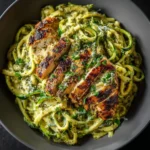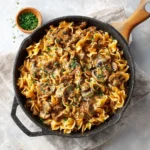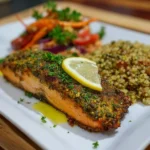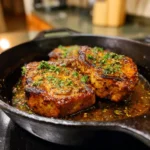Introduction
Moroccan Spiced Lamb (or Turkey) Meatball Tagine is a vibrant, aromatic North African dish that captures the essence of Moroccan cuisine through its deep layers of spices, tender meatballs, and richly flavored sauce. Traditionally slow-cooked in a conical clay pot known as a tagine, this dish brings together succulent ground lamb or lean turkey with a fragrant blend of warm spices, dried fruits, and fresh herbs. The result is a comforting stew-like meal perfect for gatherings, family dinners, or anyone seeking an exotic culinary adventure from the comfort of their kitchen. Whether you’re new to Moroccan cooking or a seasoned enthusiast, this recipe offers a delicious gateway into the country’s celebrated food culture.
The History
The origins of the tagine trace back centuries to the ancient Berber civilizations of North Africa, particularly in Morocco, Algeria, and Tunisia. The unique conical lid of the tagine pot allows steam to circulate and condense, returning moisture to the ingredients and creating deeply flavorful dishes with minimal liquid. This method was ideal for nomadic lifestyles and resource-limited environments, where slow-cooking preserved nutrients and enhanced tenderness. Over time, trade routes introduced exotic spices like saffron, cinnamon, and ginger to Moroccan kitchens, enriching the complexity of tagine recipes. The meatball version—known locally as kefta tagine—often features spiced ground meat simmered in tomato sauce or broth with vegetables or dried fruits. Historically served during religious festivals, weddings, and communal meals, tagines reflect Morocco’s emphasis on hospitality and shared dining. Today, variations abound across regions, but the soul of the dish remains rooted in tradition, patience, and the art of balancing sweet, savory, and spicy elements.
Ingredients Breakdown
The magic of Moroccan Spiced Lamb (or Turkey) Meatball Tagine lies in its carefully curated ingredients, each contributing depth, aroma, and texture. Here’s a detailed breakdown:
- Ground Lamb or Turkey: Lamb offers a rich, robust flavor traditionally used in Moroccan kefta, while turkey provides a leaner, lighter alternative without sacrificing protein content.
- Onion and Garlic: These aromatics form the flavor base, adding sweetness and pungency when sautéed.
- Fresh Herbs (Parsley and Cilantro): Essential in Moroccan cooking, they lend brightness and freshness to both meatballs and sauce.
- Spices – Cumin, Coriander, Paprika, Ginger, Cinnamon, Turmeric, Cayenne Pepper: A signature spice blend that defines the dish. Cumin and coriander offer earthiness; paprika adds color and mild heat; ginger and cinnamon contribute warmth; turmeric gives golden hue and anti-inflammatory benefits; cayenne adjusts spice level.
- Salted Butter or Olive Oil: Used for sautéing; butter enhances richness, while olive oil keeps it lighter and more authentic to Mediterranean diets.
- Tomatoes: Either canned crushed tomatoes or fresh ripe tomatoes form the tangy, luscious base of the sauce.
- Chicken or Vegetable Broth: Adds depth and helps create a silky sauce consistency during slow cooking.
- Dried Fruits (Apricots, Raisins, or Prunes): A hallmark of Moroccan cuisine, these provide natural sweetness that balances the savory and spicy notes.
- Almonds (toasted or slivered): Often sprinkled on top for crunch and nutty flavor, especially in festive versions.
- Lemon Juice or Preserved Lemon (optional): For a bright, citrusy zing that cuts through the richness.
- Harissa Paste (optional): A North African chili paste that intensifies heat and complexity.
- Eggs and Breadcrumbs (for binding meatballs): Helps hold the meat mixture together during cooking.
This harmonious combination results in a multi-dimensional dish where every bite reveals a new layer of flavor.
Step-by-Step Recipe
- Prepare the Meatballs: In a large mixing bowl, combine 1 pound of ground lamb or turkey, 1/2 cup finely chopped onion, 2 cloves minced garlic, 1/4 cup each of chopped fresh parsley and cilantro, 1 teaspoon ground cumin, 1 teaspoon ground coriander, 1/2 teaspoon smoked paprika, 1/2 teaspoon ground ginger, 1/4 teaspoon ground cinnamon, 1/4 teaspoon cayenne pepper (adjust to taste), 1 beaten egg, 1/4 cup breadcrumbs, salt, and freshly ground black pepper. Mix gently with your hands until just combined—do not overmix. Shape into small, bite-sized balls (about 1 inch in diameter). Place on a tray and refrigerate for 15–30 minutes to firm up.
- Brown the Meatballs: Heat 2 tablespoons of olive oil or melted butter in a large skillet or tagine pot over medium-high heat. Working in batches, sear the meatballs on all sides until golden brown (they don’t need to be fully cooked inside yet). Remove and set aside.
- Sauté the Aromatics: In the same pot, add another tablespoon of oil if needed. Sauté 1 diced onion until translucent (about 5 minutes). Add 2 more minced garlic cloves and cook for 30 seconds until fragrant.
- Build the Sauce: Stir in 1 tablespoon tomato paste and cook for 1 minute. Add 1 teaspoon cumin, 1/2 teaspoon coriander, 1/2 teaspoon paprika, 1/4 teaspoon turmeric, and a pinch of cinnamon. Toast the spices for 30 seconds to release their oils. Pour in 1 can (14 oz) crushed tomatoes and stir well.
- Add Liquids and Simmer: Gradually pour in 1–1.5 cups of chicken or vegetable broth, stirring to combine. Bring to a gentle simmer.
- Return Meatballs to Pot: Carefully place the browned meatballs into the sauce, nestling them gently. Cover with a lid (or use aluminum foil if not using a traditional tagine).
- Slow-Cook: Reduce heat to low and let the tagine simmer for 25–35 minutes, allowing the meatballs to cook through and absorb the flavors. Stir occasionally to prevent sticking.
- Incorporate Dried Fruits: About 10 minutes before the end of cooking, stir in 1/3 cup of pitted and halved dried apricots or raisins. This preserves their texture and prevents overcooking.
- Finish with Freshness: Taste and adjust seasoning with salt, pepper, lemon juice, or harissa. Sprinkle with chopped fresh cilantro and parsley before serving.
- Garnish and Serve: Transfer to a serving platter or serve directly from the tagine. Top with toasted almond slivers and optional preserved lemon strips for added flair.
Tips
- Don’t Overmix the Meat: Overworking the meatball mixture can make them tough. Mix just until ingredients are incorporated.
- Chill Before Cooking: Refrigerating the shaped meatballs helps them maintain shape during browning.
- Browning Adds Flavor: Take time to properly sear the meatballs—it develops a rich fond in the pan that enhances the sauce.
- Use Low and Slow Heat: Gentle simmering ensures tender meatballs and allows flavors to meld beautifully.
- Balance Sweet and Savory: If the dried fruit makes the dish too sweet, balance it with a splash of lemon juice or a bit of harissa.
- Adjust Spice Levels: Start with less cayenne and build up based on preference. Moroccan food is flavorful but not always fiery hot.
- Simmer Uncovered at End (Optional): If the sauce is too thin, remove the lid for the last 10 minutes to reduce and thicken.
- Rest Before Serving: Let the tagine sit off heat for 5–10 minutes before serving; this improves flavor integration.
- Traditional vs. Modern Pots: While a clay tagine imparts subtle earthy notes, a heavy-bottomed Dutch oven or deep skillet works perfectly on modern stovetops.
- Make Ahead Friendly: This dish tastes even better the next day. Prepare it in advance and reheat gently on the stove.
Variations and Customizations
This versatile recipe invites endless creativity. Consider these adaptations to suit dietary needs or flavor preferences:
- Vegan/Vegetarian Version: Replace meatballs with chickpea or lentil-based falafel-style balls. Use vegetable broth and increase spices accordingly.
- Gluten-Free Option: Substitute regular breadcrumbs with gluten-free oats, almond flour, or certified GF breadcrumbs.
- Different Proteins: Try ground beef, chicken, or even fish-based meatballs for regional twists.
- Vegetable-Enhanced Tagine: Add carrots, zucchini, bell peppers, or green olives during the simmering phase for extra nutrition and texture.
- Fruit Variations: Swap apricots for prunes, dates, or figs—each brings a unique sweetness and cultural authenticity.
- Spice Tweaks: Add a pinch of saffron threads soaked in warm water for luxury, or include ras el hanout—a complex Moroccan spice blend—for deeper nuance.
- Creamy Finish: Stir in a spoonful of plain yogurt or whipped cream at the end for a richer, milder profile.
- Stuffed Meatballs: Insert a small piece of preserved lemon or almond into the center of each meatball for a surprising burst of flavor.
- One-Pot Skillet Version: Skip shaping meatballs and crumble the spiced meat into the sauce like a kefta ragù.
- Grilled or Baked Meatballs: For a smoky twist, grill or bake the meatballs instead of pan-searing.
Health Considerations and Nutritional Value
Moroccan Spiced Lamb (or Turkey) Meatball Tagine can be part of a balanced, nutrient-rich diet when prepared thoughtfully:
- Protein Source: Lamb is high in protein, iron, zinc, and vitamin B12, though higher in saturated fat. Turkey is leaner and lower in calories, making it heart-healthier for those monitoring cholesterol.
- Healthy Fats: Using olive oil instead of butter increases monounsaturated fats, beneficial for cardiovascular health.
- Antioxidant-Rich Spices: Turmeric contains curcumin, a potent anti-inflammatory compound. Cinnamon may help regulate blood sugar, and cumin aids digestion.
- Fiber and Vitamins: Tomatoes provide lycopene and vitamin C; onions and garlic contain prebiotic fibers and allicin, which support immune function.
- Natural Sugars: Dried fruits add fiber and potassium but also natural sugars. Moderation is key, especially for diabetics. Opt for unsweetened varieties.
- Sodium Control: Use low-sodium broth and limit added salt to manage hypertension risks. Avoid preserved lemons if sodium is a concern.
- Balanced Meal Pairing: Serve with whole grains like couscous or quinoa to boost fiber, or over cauliflower rice for a low-carb option.
- Pregnancy Note: Ensure meatballs are fully cooked (internal temp 160°F for lamb, 165°F for turkey). Avoid raw herbs or unpasteurized dairy garnishes if advised.
- Allergen Awareness: Nuts (almonds) and gluten (breadcrumbs) are common allergens—offer substitutions when needed.
- Portion Management: This dish is hearty; moderate portions help maintain caloric balance, especially when paired with starchy sides.
Overall, this tagine exemplifies how traditional cuisine can align with modern wellness goals—flavorful, satisfying, and nourishing.
Ingredients
For the Meatballs:
- 1 lb (450g) ground lamb or ground turkey
- 1/2 cup finely chopped yellow onion
- 2 cloves garlic, minced
- 1/4 cup fresh flat-leaf parsley, finely chopped
- 1/4 cup fresh cilantro, finely chopped
- 1 large egg, beaten
- 1/4 cup plain breadcrumbs (or gluten-free substitute)
- 1 tsp ground cumin
- 1 tsp ground coriander
- 1/2 tsp smoked paprika
- 1/2 tsp ground ginger
- 1/4 tsp ground cinnamon
- 1/4 tsp cayenne pepper (optional, for heat)
- Salt and freshly ground black pepper, to taste
- 2 tbsp olive oil or melted butter (for browning)
For the Tagine Sauce:
- 1 tbsp olive oil or butter
- 1 medium onion, diced
- 2 cloves garlic, minced
- 1 tbsp tomato paste
- 1 tsp ground cumin
- 1/2 tsp ground coriander
- 1/2 tsp smoked paprika
- 1/4 tsp ground turmeric
- 1/8 tsp ground cinnamon
- 1 (14 oz) can crushed tomatoes
- 1–1.5 cups low-sodium chicken or vegetable broth
- 1/3 cup dried apricots, halved (or raisins, prunes)
- Juice of 1/2 lemon (optional)
- 1 tsp harissa paste (optional, for spice)
- Salt and pepper, to taste
For Garnish:
- Toasted almond slivers
- Chopped fresh cilantro and parsley
- Preserved lemon slices (optional)
Directions
- In a large bowl, combine all meatball ingredients except oil. Mix gently with clean hands until evenly blended. Form into 1-inch balls (about 20–24). Place on a plate, cover, and chill for 15–30 minutes.
- Heat 2 tablespoons olive oil or butter in a large skillet, Dutch oven, or tagine pot over medium-high heat. Brown meatballs in batches, turning to sear all sides (about 6–8 minutes per batch). Do not overcrowd. Remove and set aside.
- In the same pot, add 1 tablespoon oil if needed. Sauté diced onion for 5 minutes until soft and translucent. Add minced garlic and cook 30 seconds until fragrant.
- Stir in tomato paste and cook 1 minute. Add cumin, coriander, paprika, turmeric, and cinnamon. Toast spices for 30 seconds, stirring constantly.
- Pour in crushed tomatoes and stir well. Gradually add 1 cup broth, whisking to combine. Bring to a simmer.
- Return meatballs to the pot, gently submerging them into the sauce. Cover with a tight-fitting lid or foil.
- Reduce heat to low and simmer gently for 25 minutes, stirring occasionally.
- Add dried apricots (or other fruit) and continue cooking for another 10 minutes.
- Taste sauce and adjust seasoning: add salt, pepper, lemon juice, or harissa to preference. If sauce is too thick, add remaining 1/2 cup broth. If too thin, simmer uncovered for 5–10 minutes.
- Remove from heat. Let rest 5 minutes. Garnish generously with fresh herbs, toasted almonds, and preserved lemon if using.
- Serve hot with couscous, crusty bread, or over roasted vegetables.
FAQ
Can I make this ahead of time?
Yes! This tagine reheats beautifully. Prepare it up to 2 days in advance and store in the refrigerator. Reheat gently on the stove with a splash of broth to refresh the sauce.
Can I freeze Moroccan meatball tagine?
Absolutely. Cool completely, then transfer to airtight containers. Freeze for up to 3 months. Thaw overnight in the fridge and reheat slowly.
What can I use instead of a tagine pot?
A heavy-bottomed Dutch oven, cast-iron skillet with lid, or any deep oven-safe pan works perfectly. The key is slow, even cooking with retained moisture.
Are there vegetarian alternatives?
Yes. Make chickpea or lentil “meatballs” using mashed legumes, spices, flax egg, and breadcrumbs. Simmer in the same sauce for a hearty plant-based version.
How do I know when meatballs are fully cooked?
Lamb should reach 160°F (71°C); turkey must reach 165°F (74°C) internally. They should no longer be pink inside and feel firm to the touch.
Can I use fresh fruit instead of dried?
You can, though dried fruit is traditional. Fresh apricots or peaches work well but should be added in the last 10 minutes to avoid mushiness.
Is this dish spicy?
It has warmth from cumin, ginger, and optional cayenne/harissa, but it’s not overwhelmingly hot unless you increase the chili. Adjust to your tolerance.
What to serve with Moroccan tagine?
Classic pairings include fluffy couscous, khobz (Moroccan bread), quinoa, or steamed bulgur. A side of cucumber-yogurt salad or pickled turnips complements the richness.
Can I cook this in the oven?
Yes. After browning, transfer everything to a covered oven-safe dish and bake at 325°F (160°C) for 30–40 minutes.
Where can I find preserved lemons?
Available in Middle Eastern markets, gourmet grocery stores, or online. You can also make them at home by fermenting lemons in salt and juice for 3–4 weeks.
Summary
Moroccan Spiced Lamb (or Turkey) Meatball Tagine is a soul-warming, aromatic dish that blends North African spices, tender meatballs, and sweet dried fruits in a rich, slow-simmered sauce. Hearty, healthy, and full of exotic flavor, it’s a celebration of tradition and taste in every bite.










